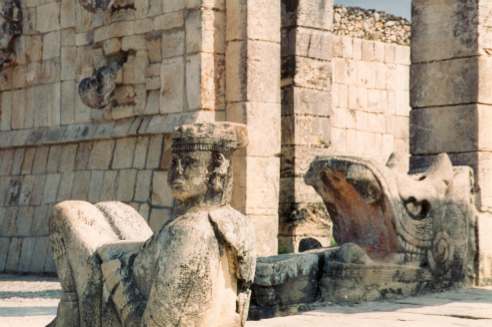| Yves' Pages |
|
|
| Machu Picchu | |
|
At 8,000 feet high, towering over the deep canyon of the Urubamba river, in Peru, Machu Picchu is a spectacular sight. Difficult to reach by road, there is a train from Cuzco that gets you to Aguas Calientes, the village in the valley below the ruins.
Conquistadors and Dominican missionaries did a very thorough job of exterminating the Inca people and culture (to "civilize" the country, no doubt), but Machu Picchu escaped: the Spanish never found it. One of the reasons was that there were not many Incas left who knew about Machu Picchu. By the time Pizzaro reached Cuzco in 1532, about half of the Inca population had died of smallpox and other European-introduced diseases. The ruins were discovered in 1911 by Hiram Bingham, a professor from Yale who was looking for the mystic and elusive last Inca stronghold of Vilcabamba. About 1,200 people lived in or around the site. Most were women, children and priests. There are about 200 buildings in the site. Some of the stonework found there is quite remarkable. Certain blocks have several dozens of different corners and still fit so tightly with the others that you cannot force a knife's blade in the joins. The tall sugarloaf peak on the background (often taken to be Machu Picchu) is Huayna Picchu, you can access it from the main site through a narrow trail and climb at the top where there are also terraces and temples. The site has been several times on the verge to be disfigured by commercial projects (hotels, casino, car cable, etc.). Several organizations fight against such change. See the latest news on that topic here. |
|
| Taj Mahal | |
|
|
The picture shows the Taj Mahal, India, in the mist of the first dawn the year 2000. This stunning construction was built by the mughal Emperor Shah Jahan. It's the mausoleum of his wife Mumtaz Mahal. Just a tomb, and for only one person. The construction started in 1632 and lasted 17 years. It is said that 20,000 workmen were employed on it daily. About a thousand elephants were used to transport from all over India and Asia the material needed. Red sandstone was brought from Fatehpur Sikri, turquoise from Tibet, jasper from Punjab, jade and crystal from China, lapis-lazuli and sapphire from Sri Lanka, coal and comelian from Arabia, and diamonds from Panna. Over all about 28 kinds of rare, semi-precious and precious stones were used in the Taj Mahal.
|
| Chichén Itzá | ||
|
The ancient city of Chichén Itzá, in Yucatán, Mexico, offers a number of astonishing ruins. One of the most proeminent, the Kukulcán/Quetzalcoatl pyramid (a.k.a "El Castillo") is about 75 feet tall and was built for astronomical purposes. During the vernal equinox (March 20) and the autumnal equinox (September 21) at about 3pm, the sunlight lights up the western balustrade of the pyramid's main stairway, causing seven isosceles triangles to form, imitating the body of a serpent 37 yards long that creeps downward to the big serpent's head carved in stone at the bottom of the stairway.
|
|
|
 |
On the left: Kukulcán (a.k.a Queztalcoatl, a.k.a the Feathered Serpent) and a Chacmol. Keep in mind that those those formidable buildings were constructed without beast of burden, without metal tools and without wheels. |
|
| Mesa Verde | |
|
The Mesa Verde National Park, in Southwestern Colorado, USA, encompasses 52,073 acres of land. From about 600 to 1300 people lived throughout the area. The last occupants, the Anasazi, made the most of the site and eventually established stone villages in the alcoves of the canyons walls. Beginning in 1276, drought struck the region, and for more than twenty years precipitation was scarce. The only solution for the villagers was to leave and seek region with a more dependable water supply. The area was abandoned. Mesa Verde is a World Heritage site. |
|
| Alhambra | |
|
|
Situated at the foot of the Sierra Nevada, on the Cerro del Sol plateau above Granada, in Andalusia, Spain, the magnificent palace-fortress of the Alhambra was build under the Moorish kings of the Nasrite dynasty. It was modified later on by the Catholic kings of Spain. The region was the last bastion of Islam in Spain until the king of Granada had to relinquish the city to Ferdinand and Isabella at the treaty of Santa Fé in 1491. |